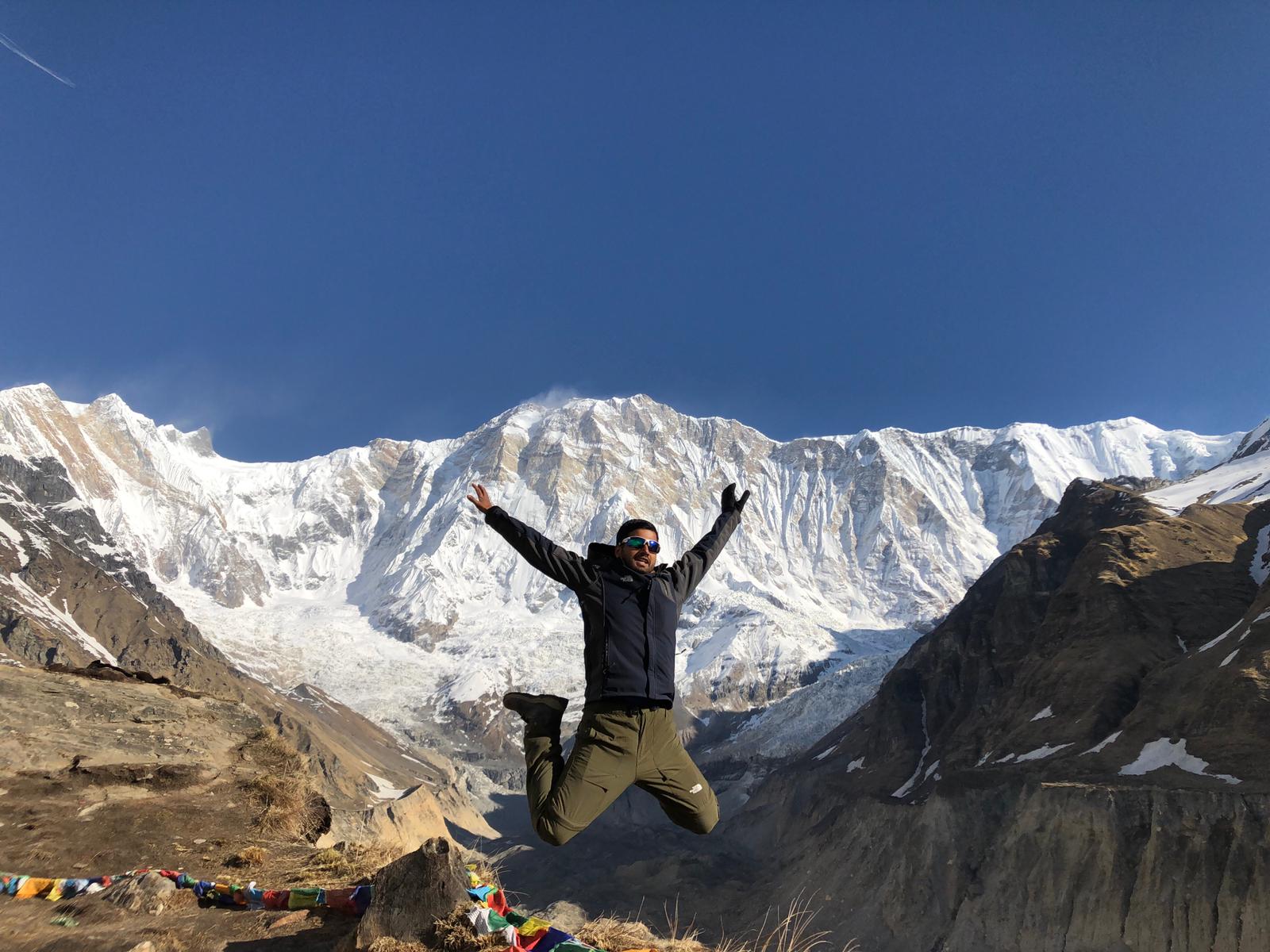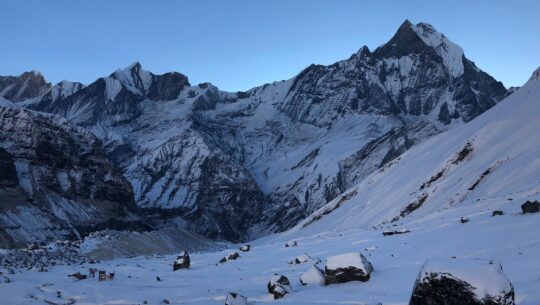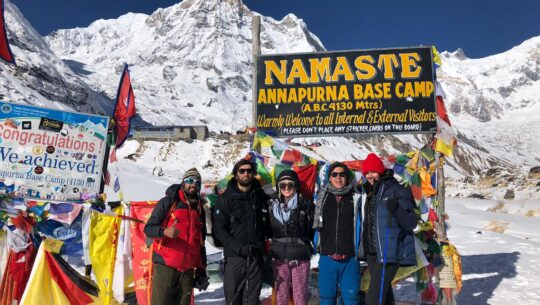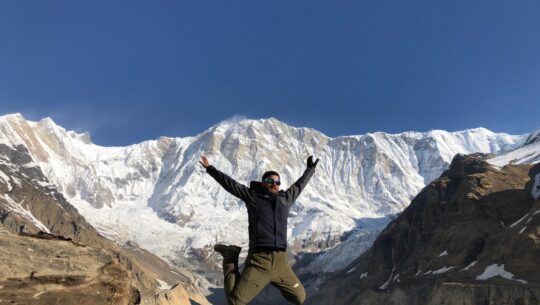Annapurna Base Camp Trek (ABC)

USD 997
8 days
Easy/Moderate
4130m
Tea House, Hotel
Car, Flight, Jeep
1-10
All around the year Except Monsoon(June-September)
Annapurna Base Camp Trek (ABC) Introduction
Annapurna Base Camp (ABC) offers a captivating trek blending nature and culture. Traversing lush forests and traditional villages, trekkers encounter the warm hospitality of Gurung and Magar communities.
Majestic peaks like Annapurna I and Machapuchare dominate the skyline, creating awe-inspiring moments. Diverse flora and fauna, including rhododendron forests and Himalayan thars, add vibrancy to the journey. Reaching the base camp is a triumph, providing a profound sense of achievement amid breathtaking surroundings. Despite challenges like steep ascents and unpredictable weather, the trek promotes sustainable tourism, fostering cultural exchange and environmental conservation.
One of the highlights of the Annapurna Base Camp trek is the diverse flora and fauna that you encounter along the way. The region is home to a wide variety of plant species, including rhododendron forests, bamboo groves, and alpine meadows. These vibrant landscapes create a kaleidoscope of colors, especially during the spring season when rhododendrons bloom in a riot of red, pink, and white. As you trek through the conservation area, you may also spot wildlife such as Himalayan thars, langurs, and various species of birds, adding an element of adventure and thrill to the journey.
Highlights
- Trekking to the Base Camp of one of Annapurna Itself
- Experiencing Gurung Hospitality & culture
- Beautiful Landscape, Nature & Rivers
- Natural Hot Spring Bath
- From Base camp see the sunrise over Annapurna Himalayas
- Visit & sightseeing in Pokhara
- See the World Heritage sights of Kathmandu
Outline Itinerary
- Day 1: Arrival Day in Kathmandu
- Day 2:- Fly to Pokhara than Drive to New Bridge thanTrek to Chomrong
- Day 3: Chhomrong to Dovan(2600M) Duration 5.5 Hours
- Day 4: Dovan to Machhapuchre Base Camp (3750M) 5Hours
- Day 5: MBC to Annapurna Base Camp(4130M) to Dovan. 8/9 Hours
- Day 6: Dovan to Jhinu Danda 6 Hours than drive to Pokhara
- Day 7:- Day sightseeing in Pokhara than fly to Kathmandu
- Day 8:- Day tour & Departure
Detailed Itinerary
Day 1: Arrival Day in Kathmandu
Welcome to the Himalayan Kingdom Nepal, Our representative will come to pick you up at the Kathmandu airport then transfer you to the Hotel in Kathmandu, check-in rest then Walking tour to Kathmandu Durbar Square A UNESCO site out of 7, visit the unique old royal palace along with many temples. At Kumari Ghar ( House of Living Goddess), we try to see the Living Goddess and then back to your hotel and stay there at Thamel(1250m).
Day 2:- Fly to Pokhara than Drive to New Bridge thanTrek to Chomrong
(35 min flight, 2.5Hours Drive &2.5hours Hike approx )
Today we start early by flying to Pokhara International Airport(beautiful mountain view from an airplane) to start your Annapurna Base Camp trekking Adventure upon arrival in Pokhara we will drive to Nayapul and then to New Bridge to start your Trekking to Chomrong Village( passing a beautiful Bridge & Jhinu(hot spring) village. Stay at Choomrong( 2050m)
Day 3: Chhomrong to Dovan(2600M) Duration 5.5 Hours
After breakfast, the trail drops to cross the Chhomrong Khola and then ascends to the charming village of Sinuwa. Thereafter the trail enters the upper Modi Khola Valley through dense forests of cane, rhododendron, and oak. It rises then drops to the village of Bamboo (2,310m/7,580ft) on the banks of the river than continues up through the uninhabited forest to Doban. Overnight at Lodge in Dovan(2600m).
Day 4: Dovan to Machhapuchre Base Camp (3750M) 5Hours
Trek through the narrow valley, surrounded by dense forests and occasional glimpses of the towering peaks. Pass through the Himalayan Hotel and continue to Deurali for mountain Lunch, then continue the hike to MBC. Overnight stay in MBC(3700m)(have also option to continue to Annapurna Base Camp).
Day 5: MBC to Annapurna Base Camp(4130M) to Dovan. 8/9 Hours
Ascend gradually, leaving the tree line behind and entering the alpine region. Trek through the glacial moraine and arrive at the Annapurna Base Camp 4130M. Witness the breathtaking panoramic early morning views of Annapurna I, Machapuchare, and other peaks. After the sun hits the snow-capped Himalayas we come down to MBC for breakfast before heading down to Dovan, staying at Dovan.
Day 6: Dovan to Jhinu Danda 6 Hours than drive to Pokhara
Trek through bamboo and rhododendron forests, descending to the Chhomrong Khola. Cross the bridge and climb uphill to Chomrong village. Then descend to Jhinu Danda Take a refreshing dip in the natural hot spring to relax and rejuvenate. Then hike down to New Bridge to catch a Local Jeep to Pokhara. Overnight stay at Pokhara.
Day 7:- Day sightseeing in Pokhara than fly to Kathmandu
After breakfast, we will take you to see a few most beautiful places in Pokhara like the Pumdikot Shiva statue with a View of Fewa Lake & Pokhara city, World Peace Stupa, Gupteshwor cave, Devis Falls & Tibetan Refugee Camp. Then after sightseeing in Pokhara we will fly to Kathmandu & stay here(1250m)
Day 8:- Day tour & Departure
After breakfast at the hotel in Kathmandu, we will take you for Full day UNESCO world heritage sightseeing tour covering Swyambhunath (known as a Monkey temple), Patan Durbar Square(ancient royal palace), Pashupatinath(where the Hindus get cremated) & Bouddhanath Stupa (a largest Buddhist Stupa on earth) Then we will bid our farewell for your final departure to your home/destination. We will drop you off at the airport.
Includes
- Four-night Simple tea houses in trekking on twin sharing basis with 3 times of meals. (Breakfast, lunch & dinner), 2 nights in Kathmandu & one Night in Pokhara in a 3-star category Hotel on a BB basis.
- All ground transportation like pick up & drops
- Full days Guided tour in Kathmandu with a City Guide
- Guided Pokhara sightseeing
- Transportation to & from the trek starting point
- A professional trekking guide, the necessary number of porters (2:1) &1 assistant guide for a group of every 12 trekkers with their salary, meal, accommodation, transportation & insurance.
- Necessary trekking permits, Annapurna Conservation area Permit, TIMS card &Rural Municipality fees
- Both ways flights from Kathmandu- Pokhara-Kathmandu,
- A group medical kit with an oximeter
Excludes
- All Kinds of beverages.
- All extra expenses such as shopping and trekking gear.
- International flights.
- Early arrival / late departure.
- Travel insurance ( must purchase one before starting the trek)
- Rescue evacuation if needed (it can be helped to arrange)
- Tips for driver, guide& porter (expected).
- If the plan changed to any other problem such as a landslide, political disturbance, changing plan, or cancellation of flight. Or the things not mentioned above
Trip Map

Annapurna Base Camp Trekking Gear List
Clothing
- Trekking Trousers
- Trekking shirts
- Inner Thermals(Top/bottom)
- Breathable Underwear
- Fleece Jacket
- Windproof jacket
- Dawn jacket
- Trekking Towel
Head Gears
- Sun Hat
- Head Band
- Buff (snood)
Hand Gear
- Inner Gloves
- Outer Gloves
Foot Gears
- Hiking Boots
- Hiking shocks
- Thermal shocks
- Gaiters
Bags
- Duffle Bag*
- Backpack (rucksack for day pack)
- A few Ziploc/waterproof bags
Equipment
- Sleeping Bag
- Sleeping bag liner (if you rent)
- Trekking Pole
- Sunglasses
- Water bottle or Hydration Bladder
- Headlamps
- Camera/video camera
- Water purification tablets*/ filters/ UV light/ staripin
- Diamox/Dzolamode
- Sunscreens
- Toiletries
- If you take any Specific medicine
Annapurna Base Camp Permits
Trekkers heading to the Annapurna Base Camp (ABC) in Nepal typically require two permits: the Annapurna Conservation Area Permit (ACAP) and the Trekkers’ Information Management System (TIMS) card. These permits are necessary for both environmental conservation efforts and trekker safety tracking.
Annapurna Conservation Area Permit (ACAP)
This permit is required for all trekkers entering the Annapurna Conservation Area, which includes the trail to the Annapurna Base Camp. The proceeds from this permit go towards the conservation of the area, Maintaining the trekking trail, and local community development projects in the area.
Trekkers’ Information Management System (TIMS) card
This card is a database of trekkers trekking in Nepal. It assists in the management and safety of trekkers by providing their information and trekking route details to authorities. And tracking a person at the different checkpoints for their safety.
These permits can usually be obtained through authorized trekking & tour agencies or the Nepal Tourism Board in Kathmandu or Pokhara. However, specific requirements and procedures may change, so trekkers need to check for updates and current regulations with the trekking agency before embarking on their journey.
Is Annapurna Base Camp for Beginners?
The Annapurna Base Camp (ABC) trek can be suitable for beginners with a reasonable level of fitness and preparation. Here’s why:
Moderate Difficulty
While the ABC trek involves ascending to higher altitudes, the overall trekking difficulty is considered moderate. The trail is well-established, and there are teahouses along the route providing accommodation and meals, which makes it accessible for beginners.
Gradual Altitude Gain
The trek allows for gradual acclimatization as you ascend, reducing the risk of altitude sickness. Proper acclimatization is essential, and the ABC route typically allows for adequate time for your body to adjust to higher altitudes.
Stunning Scenery
The trek offers breathtaking views of the Annapurna mountain range, including Annapurna I (8,091m), Machapuchare (6,993m), and other peaks. The stunning landscapes, including lush forests, terraced fields, and alpine meadows, make the journey enjoyable and rewarding.
Cultural Experience
Along the trek, you’ll pass through traditional villages inhabited by diverse ethnic communities, providing an opportunity to experience local culture and hospitality. This cultural aspect adds richness to the trekking experience.
Support Infrastructure
The ABC trek has well-established infrastructure, including teahouses offering accommodation, meals, and basic amenities. This means you don’t need to carry heavy camping gear or food supplies, making it more manageable for beginners.
Guided Options
For beginners, opting for a guided trek with experienced local guides can enhance safety and provide valuable support and knowledge about the route, culture, and environment.
While the ABC trek is generally suitable for beginners, it’s essential to prepare adequately by improving your fitness level, acclimatizing properly, and being aware of potential challenges such as altitude sickness and variable weather conditions. Additionally, having the right gear and clothing for trekking in mountainous terrain is crucial for a comfortable and enjoyable experience.
Comprehensive Guide to ABC
Trekking Day
While you are Trekking to ABC you will stay in Tea Houses (Basic Lodges that provide accommodation & Food), You will have a nice descent Tea House During the Trek to ABC, before your departure to Trekking you will need to pack your trekking bag your breakfast in Tea House, as porters will set off early. After breakfast we need to walk approximately 3-4 hours for lunchtime, some time in some places it takes even longer,
After a relaxing lunch, you typically spend around 2-3 hours or more sometimes on the trail before reaching your Tea House (Overnight Stay Place). Throughout the day, you will take frequent rest breaks and take time to admire the fascinating mountain views. You take plenty of pictures of yourself with the incredibly panoramic mountains of the Everest Region, Farmlands, Terraces, locals, Rivers, landscapes, Buddhist prayer flags, temples, shrines, cairns, monasteries, Stone Mani walls & many different heard of Mules & Yaks. Etc.
Once you arrive at your tea house, you check in at your hotel & order your dinner around 5 pm so they will have some time to prepare your dinner as the tea houses are very busy during the peak seasons. You take some rest and Dinner is generally around 6- 7 pm. After your dinner, your Trip Leader will give you a briefing for tomorrow’s trip like what time you are starting, what time you are waking, breakfast, stops, temperatures & general insight into the day so you are prepared for the day after the commentary season your crew will take your breakfast order for tomorrow. Now your bedtime!
Day Pack
You need to carry your day pack for your essential items like a water bottle, wallet, medicine (if you have any), camera, sun scream, etc. Your guide will let you know every evening after dinner about any extra items you will need for the following day. If you have a comfortable day pack your load will only be a few kilograms and hardly noticeable. You are carrying it because you may not see your porter during the trekking hours. After all, he is carrying the big loads & his pace might be different than the rest of the group.
Food/Meal
During your stay In Kathmandu descent Breakfast will be provided in the Hotel you are staying but during the trek, you will have three meals (Breakfast, Lunch, and Dinner), Every Tea House has its menu so you can order menu food items but if you are traveling in a group we request you to select from few different options as it is difficult sometimes when 20 people order 20 different verity of food in the mountain as they are basic.
Accommodations
Your Accommodation in Kathmandu will be provided deluxe room with private facilities on Breakfast basic. During the Trekking you will have Basic Descent Tea House which is a basic (normal) standard. Normally they have Clean Comfortable Twin sharing Rooms & can be arranged single supplement room for an additional cost. Hot Showers are available in some places but they will charge directly to clients when they ask for a hot shower.
Bathrooms in the Annapurna region are pretty good most of the places & tea houses have clean western toilets. All the Toilets/bathrooms are built inside the same building but only very few are inside the room (Attached). To book the Attached ones we need prior bookings & also availability. Happy Mountain Nepal is always here to book the best accommodations in your Everest Base Camp Trekking.
Transportation
Transportation in Kathmandu Valley will be with private transportation like Cars, vans, or buses depending upon the group size. In the trekking region, transportation means hiking and in some cases, Yaks/horses and donkeys are used for baggage carriage. In this trekking route, hiking is the major means of transportation while your baggage will be carried by porters.
On your journey to Annapurna Base Camp Trekking, you can also fly or drive to Pokhara and then take a Jeep or Car to the trek starting point, Annapurna Area has multiple places that have access road & off-road transportation on the need of someone.
Trekking Staff
The Trip Leader/ Guide is in overall in charge of the trek and looking after you. This is the person you should go to with all problems, concerns, and questions. All our guides are well-trained in all aspects of trekking, conservation, high-altitude medicine, and first-aid and emergency procedures. They are professionals selected for their knowledge and passion for Nepal and its people. We are hiring a local porter from Lukla as we empower the local community. Your field staff is extremely powerful to carry your bags & assist you on your journey to Annapurna Base Camp.
Grading of ABC
Annapurna Base Camp Trek is an Adventure Trekking in Nepal you must have well fitness level and be well prepared, before you come to Annapurna Base Camp Trekking it’s much better to go Swimming, Cycling, or walking every day 4 km or take the stairs instead of an elevator. Remember that no trek in the Himalayas is a stroll as all treks involve going up and down at altitude and that altitude affects everyone differently.
Money
It is better to bring the USD to Nepal because you can change it everywhere easily. You can exchange enough money for Nepalese Rupees to last the entire time of your trek before leaving Kathmandu. You can find the money exchange counters near your hotel and also get on trekking trails but they will take more commission. You have an option for withdrawing your cash on the ATMs in Kathmandu but they have limited transactions only & sometimes it may not work that easy as you have to get permission from your bank to use your card in a foreign land.
Tipping
Tipping is a personal and voluntary matter and tips are not included in the trip price, but those who will be working on this lifetime journey of ABC are expecting some tips as a measure of happiness/success to their Clint. You can directly reward them for their big support for your journey. Tipping has no limitation on specific rates so you can give tips as much as you like if they make you happy with your trip.
Insurance
It is an important part of the trip. Your Travel insurance is not included in the trip price. Your travel insurance must provide coverage against personal accident, medical expenses, emergency evacuation and repatriation (including helicopter evacuation), and personal liability. It includes trekking crews and also against personal accidents the company will have field staff Insurance for emergencies.
Health
There are no specific health-related requirements for travel to Nepal. However, for the trekking in the Himalayas, you are in excellent health with average physical fitness and have a positive attitude, self-confidence, and strong determination, you can accomplish this trek but you should consult your doctor for up-to-date information regarding vaccinations, high altitude medication and medications for any reasonably foreseeable illnesses whilst traveling in Nepal.
Some parts of trekking have a small health post for emergency treatment with limited equipment, limited health workers, and medication. (Himalayan Rescue Associations) Be aware that some drugs, including anti-malarial, have side effects at altitude. Please discuss this carefully with your doctor.
Be aware that you will be in remote areas and away from medical facilities for some time during this trip. We strongly recommend that you carry a personal First Aid kit as well as sufficient quantities of any personal medical requirements (including a spare pair of glasses). Happy Mountain Nepal Field crew will also have a comprehensive first-aid kit through the ABC trek.
High Altitude Sickness
AMS (acute mountain sickness) is a serious issue. It is the result of the failure of the body to adapt to high altitude and can affect anyone, regardless of age or fitness. It usually occurs above 2,500 meters and the likelihood of being affected increases as you ascend. The way to reduce the effects of altitude is to ascend slowly, 300-500 meters per day above 3,000 meters until you have acclimatized.
Poor acclimatization results in headache, nausea, sleeplessness, difficulty breathing, and swelling of fingers and glands. The only cure for AMS is to descend to a lower altitude and your guide’s decision on this matter is final. When you are planning to trek above 3,000 meters we recommend not walking faster. Walking slowly, drinking plenty of fluids, proper acclimatization is crucial. If you get altitude sickness or any health-related symptoms please consult with your guide/trip leader to go down at least 500 meters to recover.
Why ABC trek with Happy Mountain
Annapurna Base Camp Trekking with Happy Mountain Nepal Pvt Ltd offers several benefits for adventurers seeking memorable experiences in the Himalayas:
Expert Guidance
Happy Mountain Nepal employs experienced guides who are familiar with the local terrain, culture, and safety protocols. They can enhance your trekking experience by providing insights into the surroundings and ensuring your safety throughout the journey.
Tailored Itineraries
The Company offers a variety of trekking routes and customizable itineraries to suit different preferences and fitness levels. Whether you’re a beginner or an experienced trekker, Happy Mountain Nepal can design a trekking package that meets your specific needs and interests
Cultural Immersion
Trekking with Happy Mountain Nepal provides opportunities to immerse you in the rich cultural heritage of Nepal. You can interact with local communities, visit traditional villages, and learn about the customs and traditions of the Himalayan people along the way.
Stunning Scenery
Nepal is home to some of the world’s most breathtaking landscapes, including snow-capped peaks, lush forests, and picturesque valleys. Trekking with Happy Mountain Nepal allows you to experience these stunning vistas up close and capture unforgettable moments in nature.
Responsible Tourism
Happy Mountain Nepal is committed to promoting responsible tourism practices that minimize negative impacts on the environment and support local communities. By choosing to trek with them, you can contribute to sustainable development initiatives and conservation efforts in the region.
Overall, trekking with Happy Mountain Nepal offers a unique opportunity to explore the beauty and diversity of the Himalayas while enjoying personalized service, cultural immersion, and unforgettable adventures.







